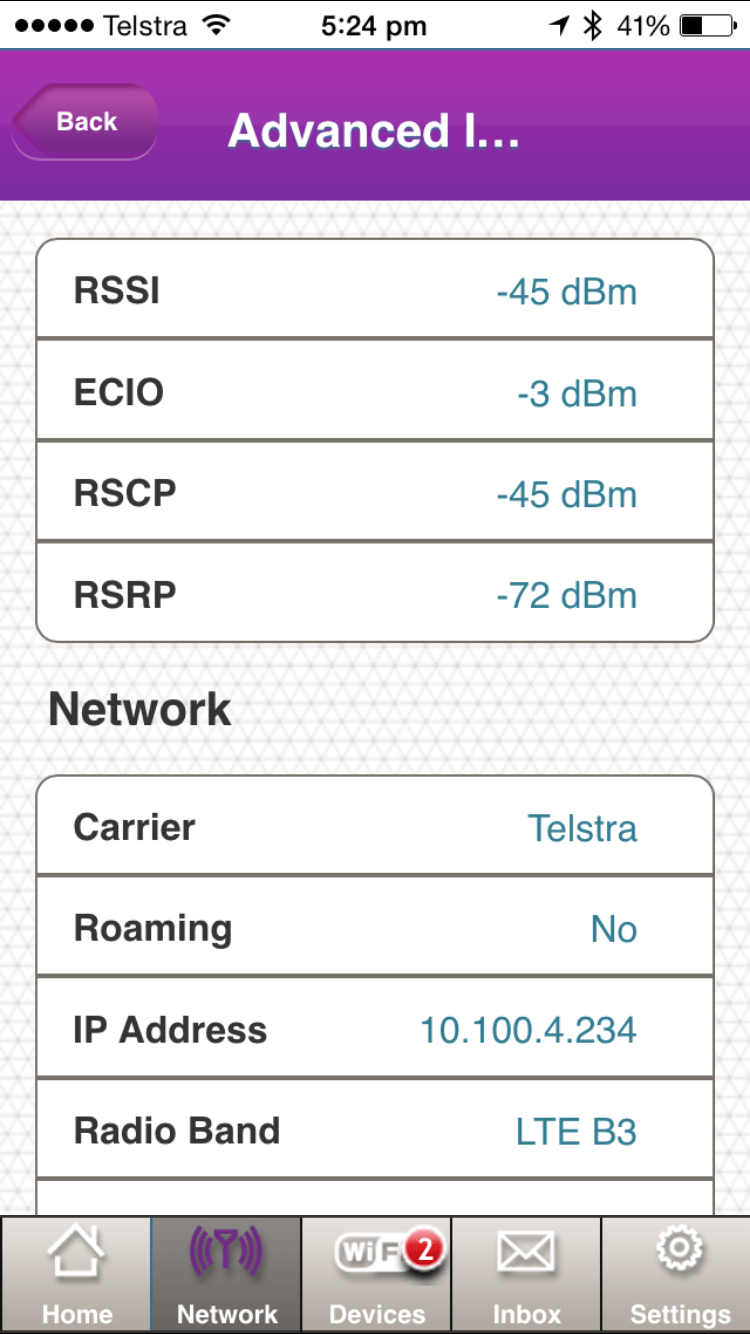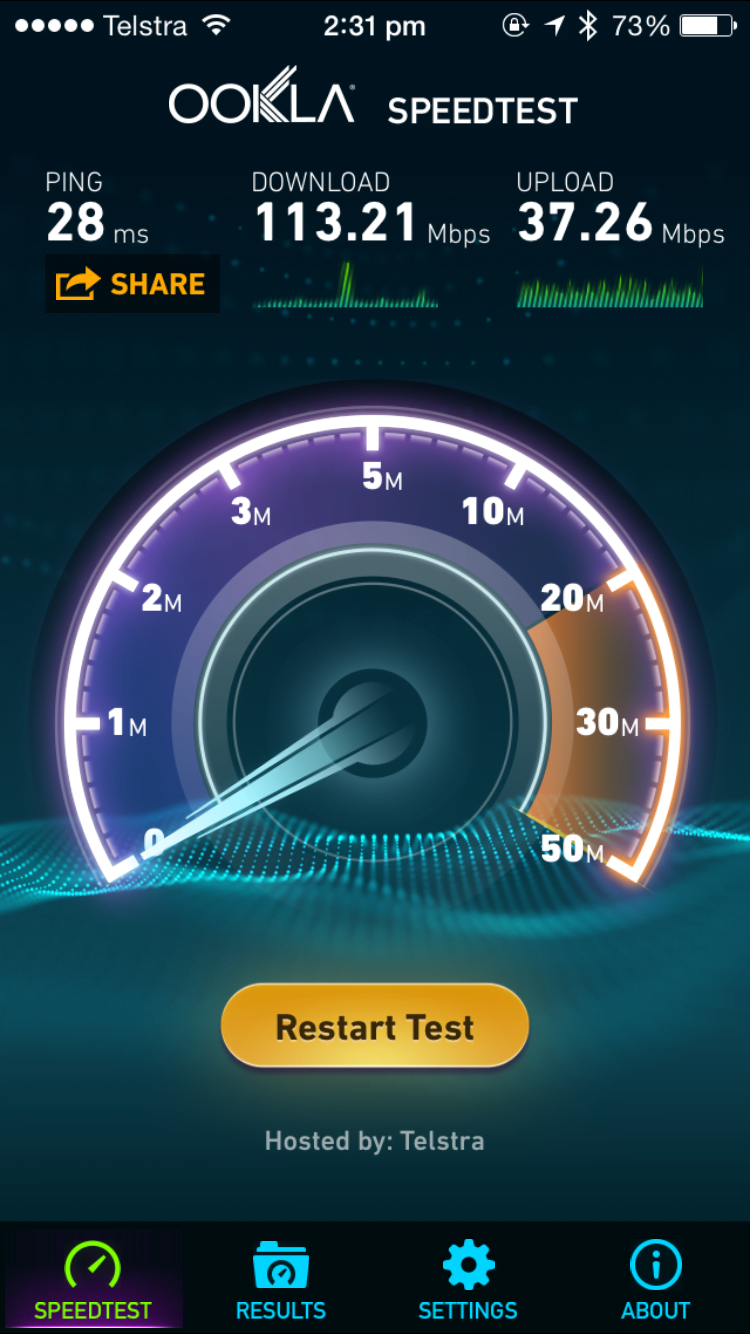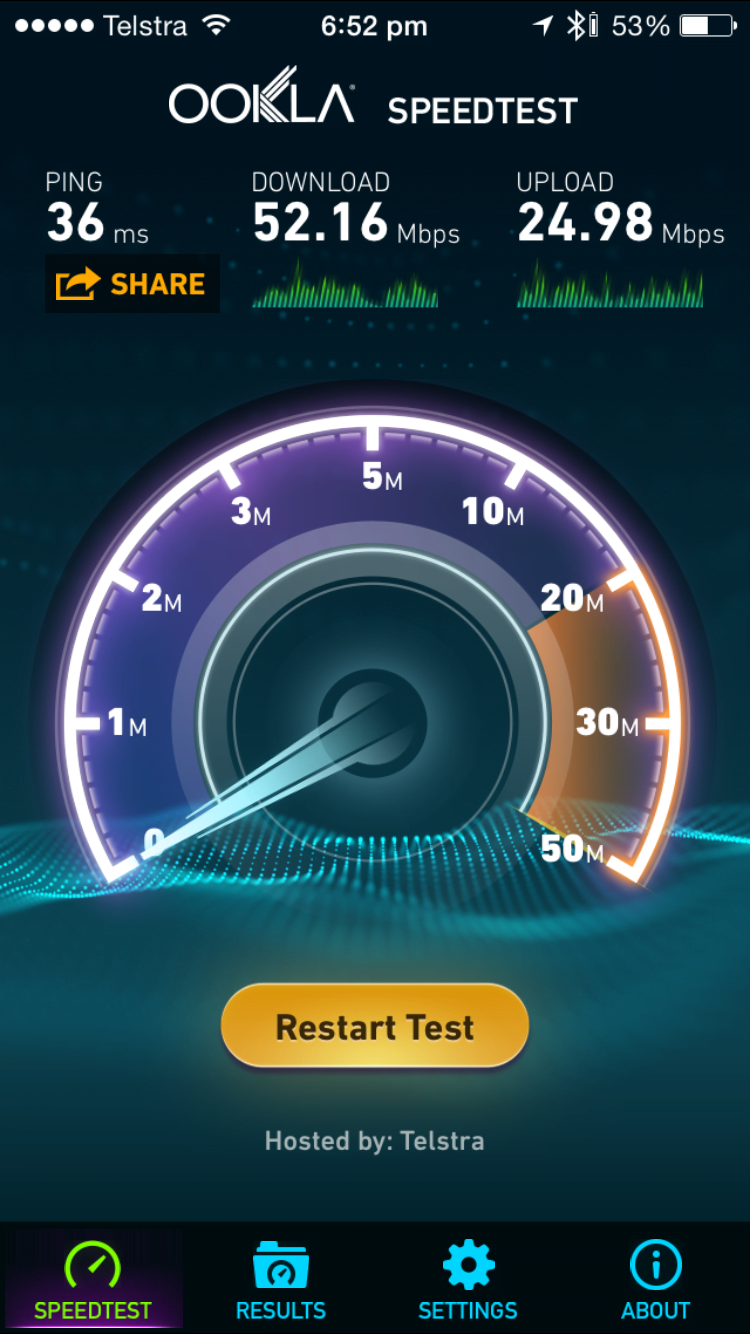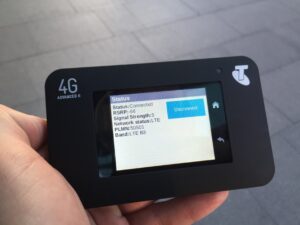The Netgear AirCard 790s (also known as the Telstra Wi-Fi 4G Advanced II) is the first device sold by Telstra to support LTE on all current and future bands, and support LTE-A CA (carrier aggregration) across multiple bands. It’s also the first hotspot to carry the new 4GX branding. You’ll always get the fastest speeds possible, today and into the foreseeable future, with support for LTE on bands 1 (2100mhz), 3 (1800mhz), 7 (2600mhz), 8 (900mhz) and 28 (700mhz). And 3G too, so you’re covered everywhere. The 790s also supports LTE-A CA on bands 3+28, 28+7, 3+7 and 7+7 – for typical speeds of between 2Mbps to 100Mbps in a 4GX area. In a standard 4G area, you should see typical download speeds of 2Mbps to 50Mbps.
The 790s is decently sized, fitting into your palm. On the bottom, you have two external antenna ports, a microUSB 3 port (though only a microUSB 2 cable is included in the box) – presumably to make the most out of tethering over USB. On top, you have a power button.
The front of the device is made up of a touchscreen, with home and back capacitive buttons on the right side. The majority of features and settings can be operated from here, without having to open up the AirCard app or the web based UI. You can see how many WiFi clients are connected, change WiFi settings (enable dual band WiFi, block/unblock devices by MAC, turn on guest wifi, easily connect devices that support WPS), enable airplane mode, change networks settings (lock to 3G, 4G or ‘auto’matically switch between the two), view your network status (check out the LTE band you’re connected to), and also see your data usage at a glance – which is more useful now Telstra updates this in ‘near’ real time.
Popping the back cover off reveals a removable battery, with the micro-SIM slot hidden underneath – so you’ll need to pull the battery out to swap cards around.
In terms of branding, there’s a small ‘Telstra’ logo in the top left, with ‘WiFi Advanced’ also stamped on the front. The battery cover on the back has a subtle ‘Netgear’ logo included.
Connecting the 790s to a computer, running either Windows 7, 8 or Mac OS X, was completed quickly and painlessly configured itself as an additional network interface without having to jump through hoops – you may want to double check this and disable USB tethering – connecting the 790s to your computer to charge could result in all traffic being sent out over the 790s instead of the WiFi or Ethernet connection that computer may already be using.
Battery life on the 790s is excellent – turning on the 790s at 8am, and throwing it in my bag – with my laptop, phone and tablet connected – it easily lasts a full working day, with about 20% battery life left at home time (5pm) – even in areas where the network strength may not be the best. Out of the box the 790s will turn WiFi into standby after 5 minutes if inactivity – a press of the power button will enable WiFi again after a few seconds.
There’s also the option of utilising ‘Jump Boost’ – a microUSB to female USB adapter is included in the box – so you can plug in another device via USB and use the 790s as an external battery – which is one less thing to carry in your bag, provided you don’t completely drain the 790s when you still need internet after!
The network performance of the 790s is brilliant – you’ll need to use USB or have an 802.11ac device in order to get the most out of it.
In a 4GX area, speed tests are consistently above 80Mbps, and can peak around 130Mbps. Using the network status screen in either the free iOS or Android app, or on the device itself – will show the primary band that the device is connected to.
Typically, in a 4GX area, you’ll see speeds of between 2 and 100Mbps
Unfortunately – there is no indication to show when you have an LTE-A CA connection or what the other band is. It’s also not possible to lock the device to a specific LTE band from the web UI or associated app – presumably then you would completely lose the benefits of being in an LTE-A CA area.
Outside of a 4GX area, or an area supporting LTE-A CA, the 790s still manages to pull a more than reasonable 30-50Mbps over 4G from around Sydney’s CBD and surrounding areas.
If you manage to sit around Sydney CBD, you might even be able to play LTE band bingo, with a number of bands active and live.
Conclusion
The Telstra Wi-Fi 4G Advanced II is a excellent mobile hotspot for anyone who needs the internet while on the go; with support for to get the best out of 4G today, and ready for more 4G into the future.
The Netgear AirCard 790s and included SIM were provided by Telstra.
Specifications
Network:
4G (Cat 6) CA: 1800MHz+700MHz, 1800+2600, 2600+700, 2600+2600 MHz
4G 700/900/1800/2100/2600 MHz
3G 850/900/1900/2100 MHz
Dimensions: 110(L) x 68(W) x 15(H)mm
Weight: 136 grams
Active Battery: 2930mAh – up to 11 hours, standby up to 200 hours.
Pricing
The Telstra Wi-Fi 4G Advanced II is available from today, Tuesday 25 November on a range of 24 month consumer and business plans from Telstra.
Consumer customers can purchase it for no additional device payment on a $55 Plan when they stay connected for 24 months, with 8GB of included data each month to use in Australia (min cost $1,320, data 67c/MB)
Business customers can purchase it for no additional device payment on the $65 Telstra Mobile Broadband Business Share Plan when they stay connected for 24 months (min cost $1,560, data 79c/MB), with 8GB of included data each month to use in Australia
Things you need to know
















